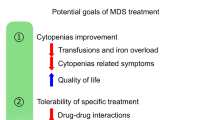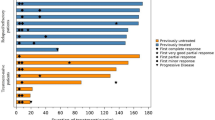Abstract
An IV form of busulfan (IV Bu) has recently become available for high dose conditioning regimen before haematopoietic stem cell transplantation (HSCT). This IV form is expected to reduce the high pharmacokinetic variability exhibited with oral busulfan and as a result, to better target the plasma area under the curve (AUC). Pharmacokinetics (PK) of IV Bu was investigated on 127 adult patients (333 PK administrations) who received 0.8 mg·kg−1 of Bu as a 2-h infusion every 6 h over 4 days, followed by cyclophosphamide (60 mg·kg−1 day−1×2). A retrospective population PK analysis was carried out to search for important predictive factors of IV Bu PK and to develop a limited sampling strategy (LSS) through Bayesian methodology. The analysis was conducted using the Non Linear Mixed Effect methodology and included a validation process on an independent data set. Adjusted Ideal Body Weight (AIBW) and Body Surface Area (BSA) were the best covariates to explain the inter-patient variability. The final inter-patient variability (CV=16%) in IV Bu clearance (Cltot) was estimated close to the intra-patient variability (CV=13%). There was neither age-dependency nor gender effect. IV Bu Cltot was not affected by elevated hepatic enzymes or by co-administration of either fluconazole or acetaminophen, and was not altered in heavily pre-treated or pre-transplanted patients. Normalised Cltot based on either AIBW or BSA was comparable between normal and obese patients (BMI=18–26.9 kg·m−2, >26.9 kg·m−2, respectively) whereas significant differences existed when based on either actual (ABW) or ideal body weight (IBW). As a consequence, no dose adjustment is required in obese patients when using a AIBW- or BSA-based dose calculation. A fixed dose of 0.80 mg·kg−1 of AIBW or 29 mg·m−2 of BSA yielded an average AUC of 1,200 μM·min, with 80% of patients within the “therapeutic” AUC range of 900–1,500 μM·min. Alternatively, 0.80 mg·kg−1 based on either ABW or IBW for normal patients and on AIBW for obese patients would achieve the same performance. A limited sampling strategy based on a Bayesian methodology was developed and validated on an independent dataset: AUCs obtained from one to two samplings were demonstrated to be reliably estimated.



Similar content being viewed by others
References
Andersson BS, Kashyap A, Gian V et al (2002) Conditioning therapy with intravenous busulfan and cyclophosphamide (IV BuCy2) for hematologic malignancies prior to allogeneic stem cell transplantation: a phase II study. Biol Blood Marrow Transplant 8:145–154
Andersson BS, Thall PF, Madden T et al (2002) Busulfan systemic exposure relative to regimen-related toxicity and acute graft-versus-host disease: defining a therapeutic window for IV BuCy2 in chronic myelogenous leukaemia. Biol Blood Marrow Transplant 8:477–485
Beal SL, Sheiner LB (1998) NONMEM user’s guide. University of California, San Francisco
Bostrom B, Enockson K, Johnson A et al (2003) Plasma pharmacokinetics of high-dose oral busulfan in children and adults undergoing bone marrow transplantation. Pediatr Transplant 7(suppl 3):12–18
Buggia I, Zecca M, Alessandrino EP et al (1996) Itraconazole can increase systemic exposure to busulfan in patients given bone marrow transplantation. Anticancer Res 16:2083–2088
Copelan EA, Bechtel TP, Avalos BR et al (2001) Conditioning regimens: busulfan levels are influenced by prior treatment and are associated with hepatic veno-occlusive disease and early mortality but not with delayed complications following marrow transplantation. Bone Marrow Transplant 27:1121–1124
Czerwinsky M, Gibbs JP, Slattery JT (1996) Busulfan conjugation by glutathione S-transferases α, μ, and π. Drug Metab Dispos 24:1015–1019
Dix SP, Wingard JR, Mullins RE et al (1996) Association of busulfan area under the curve with veno-occlusive disease following BMT. Bone Marrow Transplant 17:225–230
Ehrsson H, Hassan M, Ehrnebo M, Beran M (1983) Busulan kinetics. Clin Pharmacol Ther 34:86–89
Embree L, Heggie JR, Knight G et al (1997) Effect of phenytoin on busulfan pharmacokinetics. Pharm Res 14, 11, suppl. S613–abstract#3455
Gibbs JP, Gooley T, Borneau B et al (1999) The impact of obesity and disease on busulfan oral clearance in adults. Blood 93(12):4436–4440
Gibbs JP, Liacouras CA, Baldassano RN, Slattery JT (1999) Up-regulation of glutathione S-transferase activity in enterocytes of young children. Drug Metab Dispos 27:1466–1469
Gibbs JP, Murray G, Risler L et al (1997) Age-dependent tetrahydrothiophenium ion formation in young children and adults receiving high-dose busulfan. Cancer Res 57:5509–5516
Grochow LB (1993) Busulfan disposition: the role of therapeutic monitoring in bone marrow transplantation induction regimens. Semin Oncol 20(4 suppl 4):18–25
Grochow LB, Jones RJ, Brundrett RB et al (1989) Pharmacokinetics of busulfan: correlation with veno-occlusive disease in patients undergoing bone marrow transplantation. Cancer Chemother Pharmacol 25:55–61
Hassan M, Ljungman P, Bolme P et al (1994) Busulfan bioavailability. Blood 84:2144–2150
Hassan M, Nilsson C, Hassan Z et al (2002) A phase II trial of liposomal busulphan as an intravenous yeloablative agent prior to stem cell transplantation: 500 mg/m2 as a optimal total dose for conditioning. Bone Marrow Transplant 30:833–841
Hassan M, Oberg G, Bekassi AN et al (1991) Pharmacokinetics of high-dose busulphan in relation to age and chronopharmacology. Cancer Chemother Pharmacol 28:130–134
Hassan M, Oberg G, Björkholm M et al (1993) Influence of prophylactic anticonvulsant therapy on high-dose busulphan kinetics. Cancer Chemother Pharmacol 33:181–186
Hassan M, Oberg G, Ehrsson H et al (1989) Pharmacokinetic and metabolic studies of high-dose busulphan in adults. Eur J Clin Pharmacol 36:525–530
Leather HL (2004) Mini-review: drug interactions in the hematopoietic stem cell transplant (HSCT) recipient: what every transplanter needs to know. Bone Marrow Transplant 33:137–152
Lindley C, Shea T, McCune J et al (2004) Intraindividual variability in busulfan pharmacokinetics in patients undergoing a bone marrow transplant: assessment of a test dose and first dose strategy. Anti-Cancer Drugs 15:453–459
Nation RL, Evan AM, Milne RW (1990) Pharmacokinetic drug interactions with phenytoin (part I). Clin Pharmacokinet 18(1):37–60
Nguyen L, Fuller D, Lennon S, Leger F, Puozzo C (2004) IV busulfan in pediatrics: a novel dosing to improve safety/efficacy for hematopoietic progenitor cell transplantation recipients. Bone Marrow Transplant 33(10):979–987
Nieto Y, Vaughan WP (2004) Pharmacokinetics of high-dose chemotherapy. Bone Marrow Transplant 33:259–269
Nilsson C, Aschan J, Hentschke P et al (2003) Conditioning regimens: the effect of metronidazole on busulfan pharmacokinetics in patients undergoing hematopoietic stem cell transplantation. Bone Marrow Transplant 31:429–435
Poonkushali B, Chandy M, Srivastava A et al (2000) Glutathione S-transferase activity influences busulfan pharmacokinetics in patients with beta thalassemia major undergoing bone marrow transplantation. Drug Metab Dispos 29:264–267
Sandström M, Karlsson MO, Ljungman P et al (2001) Population pharmacokinetic analysis resulting in a tool for dose individualization of busulphan in bone marrow transplantation recipients. Bone Marrow Transplant 28:657–664
Schuler U, Renner UD, Kroschinsky F et al (2001) Intravenous busulphan for conditioning before autologous or allogeneic human blood stem cell transplantation. Br J Haematol 114:944–950
Schuler U, Schroer S, Kühnle A et al (1994) Busulfan pharmacokinetics in bone marrow transplant patient: is drug monitoring warranted? Bone Marrow Transplant 14:759–765
Shulman HM, Hinterberg W (1992) Hepatic veno-occlusive disease—liver toxicity syndrome after bone marrow transplantation. Bone Marrow Transplant 10:197–214
Slattery JT, Clift RA, Buckner CD et al (1997) Marrow transplantation for chronic myeloid leukaemia: the influence of plasma busulfan levels on the outcome of transplantation. Blood 89:3055–3060
Slattery JT, Sanders JE, Buckner CD et al. (1995) Graft-rejection and toxicity following bone marrow transplantation in relation to busulfan pharmacokinetics. Bone Marrow Transplant 16:31–42
Vassal G, Ré M, Gouyette A (1988) Gas chromatographic-mass spectrometry assay for busulfan in biological fluids using deuterated internal standard. J Chromatogr 428:357
Author information
Authors and Affiliations
Corresponding author
Rights and permissions
About this article
Cite this article
Nguyen, L., Leger, F., Lennon, S. et al. Intravenous busulfan in adults prior to haematopoietic stem cell transplantation: a population pharmacokinetic study. Cancer Chemother Pharmacol 57, 191–198 (2006). https://doi.org/10.1007/s00280-005-0029-0
Received:
Accepted:
Published:
Issue Date:
DOI: https://doi.org/10.1007/s00280-005-0029-0




